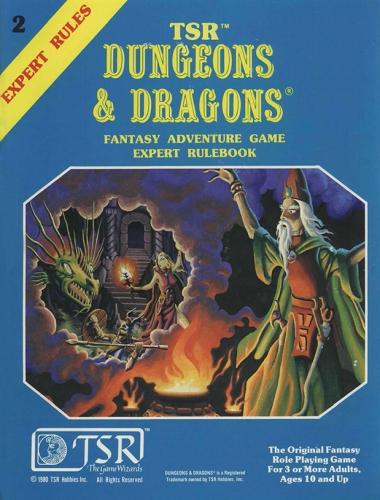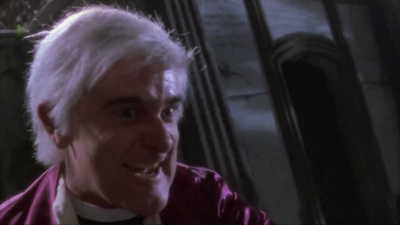Dungeons & Dragons
Fantasy Adventure Game
Expert Rulebook

The Original Fantasy Role Playing Game
For 3 or More Adults, Ages 10 and Up
(TSR Hobbies, 1980. 64 pages)
This one is blue. Interesting cover, but not nearly as cool as the Basic Set. It's okay, but nothing too impressive.
In the original Box Set, this book came bundled with the module X1: Isle of Dread, also written by Cook, and which is probably one of the most highly regarded adventures ever made. I might perhaps cover this after the Expert Set is done. (Because it is indeed very good, but also very unlike any other modern modules.)
The first page is a number of tables from the Basic Set, like the Ability Score modifiers, missile weapon ranges, and all the Encumbrance rules. The idea here seems to be that you have any tables you might need too look up during a game in a single book. Very thoughtful.
Part 1: Introduction
Obviously, this is an expansion to the Basic Set and assumes that you know how Basic works. The idea of reassembling the two books into one is mentioned again, but without printing all 128 pages (which I won't) it's hard to get an impression of how good that would actually look.
The Expert Set has rules for letting characters advance to 14th level, and includes new spells, magic items, monsters, and treasures for such higher level adventures. (Or lower levels when you go to dungeons.  ) There is also a big deal being made from going beyond dungeon adventures into wilderness adventures. "In expanding the campaign, the DM will create whole nations and cultures, giving the characters a history and background. Adventurers can even shape the hisoty of their world as they become more powerful." We're going to see how well the book delivers on this lofty promise later on.
) There is also a big deal being made from going beyond dungeon adventures into wilderness adventures. "In expanding the campaign, the DM will create whole nations and cultures, giving the characters a history and background. Adventurers can even shape the hisoty of their world as they become more powerful." We're going to see how well the book delivers on this lofty promise later on.
At higher levels, players also may build strongholds for their characters and then become lords of their own territories.
A few new terms are introduced as well: A wilderness is any area that is outdoors. When characters reach 9th level, they have achieved name level, as by then a magic-user is called a "wizard" and a fighter a "Lord", and their title won't be changing any more after that. (At the lower levels, every class level comes with a fancy sounding title that doesn't actually mean anything.) When characters build their own fortified base, it is called a castle when build by fighters, clerics, or wizards, a hideout when build by thieves, and a stronghold when build by demhumans.
A new concept introduced here are reversed spells, which allows spellcasters to cast their spells for the opposite effect they usually know. There is also magical research, which allows spellcasters to invent new spells and make magic items. "Many details of magical research are left the DM." Interesting they already felt the need to mention that here in the introduction of the book.
There's a historically very interesting paragraph on the second page of the introduction. At least if you have an interest in early D&D and the nerdiest aspects of OSR.
Most important, the characters in the wilderness campaign do not exist in a vacuum. The DM should have events going on elsewhere that may affect (or be affected by) the actions of the players. There may be any number of "plots" going on at once, and the DM should try to involve each player in some chain of events. These should develop logically from the actions of those involved.
It is important not to force the action to a pre-determined conclusion. The plot lines can
always be adjusted for the actions of the players.
This could very well be argued to be official definition of what is now usually called Sandbox campaigns. You could write small books about this quote alone. (And I am pretty sure someone did.) I won't go into that here in great detail as there is plenty of more immediate stuff, but it's interesting to see that Cook was stressing some points about open world campaigns that are still the source of great debate 35 years later.
Since player characters die with considerable frequency and the default assumption is that all new characters are created at 1st level, "As a guideline, not a rule, it is suggested that characters who have a difference in levels of 5 or greater" should not play in the same adventures. The reason for that being that a 1st level character in a 6th level party would not have any realistic chance of surviving anything the party might run into and that a 12th level character in a 6th level party would simply clear out all obstacles by himself, reducing the other characters to supporting spectators. Still, I can imagine a great number of 3rd edition players considering even a 5 level difference an outrage and a travesty.
The suggestion that a 3rd level character and an 8th level character should probably play in different adventures seems strange though. This seems based on the assumption that D&D is played in wargaming clubs where there are plenty of different games run by different groups. However, the Basic Set explicitly mentioned that B/X is meant to make D&D accessible to people beyond this original crowd, so it seems a bit out of place. The obvious alternative solution would be to have new characters created 5 levels below the highest level character in the party.
There's also a couple of extra notes for people who want to use the Expert Set with the older Holmes Basic rules. I know nothing about that one, but I assume the Expert Set would indeed have everything needed to do that. The only thing it's really missing are combat rules, monsters, and spells, which the Holmes Basic set most likely already had in a very similar form.
Part 2: Player Character Information
This is mostly updated tables for each character class, expanded up to 14th level. One important new information is that player characters can only get a maximum of 9 Hit Dice. After that, they no longer roll for new hit point and adding their Constitution modifier when leveling up. They simply get 1 or 2 more hp, depending on their class.
In addition to increasing numbers for attack chances, saving throws, and spells per day, there are also a few new abilities that become available to higher level characters n Expert.
Cleric
As I mentioned in the Basic Rules, the turn undead ability of clerics is really immensely powerful as it can be used every single round all day long. At 2nd level, a cleric will automatically turn 2-12 skeletons and at 3rd level 1-6 zombies every round. At 4th level, this ability becomes a lot more badass. Not only can the cleric automatically turn 1-6 ghouls, those 1-12 skeletons are automatically "destroyed or desintegrated"! At 5th level that happens to the zombies and at 6th level to the ghouls!
 I kick arse for the LORD!
I kick arse for the LORD!
Totally hardcore. I can see why LotFP (kind of a horror version of B/X) made it into a spell instead.
Thief
At 4th level, thieves get the ability to read any writing as if using the read language spell with an 80% chance of success. At 10th level, they may also use wizard spell scrolls, but there's always a 10% chance that the spell will backfire in some way.
Demihumans
While the four main classes can advance to 14th level (and are all mentioned to be able to advance to 36th in the Companion Set scheduled for a later date), dwarves can only reach a maximum level of 12th, elves a maximum of 10th, and halflings a maximum of 8th. The explanation given for that is that it is "a balancing factor". Presumedly for the huge power these classes gain from having infravision and a 2 in 6 chance to hide. Which is of course completely bupkis.
This limitation exists just because. Perhaps as an "explanation", why the world is not full with super high level elves and dwarves as they live so much longer. But why would that apply to player characters? Since there isn't really anything special happening to characters as they gain higher level, this rule is very easily ignored. The tables only go to 8th or 12th level, but you can easily expand them to 36th. If you're just playing the Expert rules, it also doesn't make much of a difference, since the maximum level is 14th anyway. But this is really one thing about old D&D edition that is just utter nonsense. If anyone would actually have felt those other classes are too powerful, they could simply have made them less powerful.
Dwarves may only hire dwarven mercenaries. For no reason given. Same goes for elves.
If the GM wants the party to progress beyond 14th level with just the Basic and Expert Sets (the Companion Set came out only 4 years later), there's a short explanation of how to keep progressing attack chances and saving throws, and a simple rule for extending the XP required to get more levels.
There's a new equipment list, which I think is pretty much the same, but also has ships, riding animals, and some siege engines.
) There is also a big deal being made from going beyond dungeon adventures into wilderness adventures. "In expanding the campaign, the DM will create whole nations and cultures, giving the characters a history and background. Adventurers can even shape the hisoty of their world as they become more powerful." We're going to see how well the book delivers on this lofty promise later on.


 Re: Let's Read B/X: The Moldvay/Cook Basic and Expert Sets for D&D
We are not standing on the shoulders of giants, but on very tall tower of other dwarves.
Re: Let's Read B/X: The Moldvay/Cook Basic and Expert Sets for D&D
We are not standing on the shoulders of giants, but on very tall tower of other dwarves.



 Reply With Quote
Reply With Quote